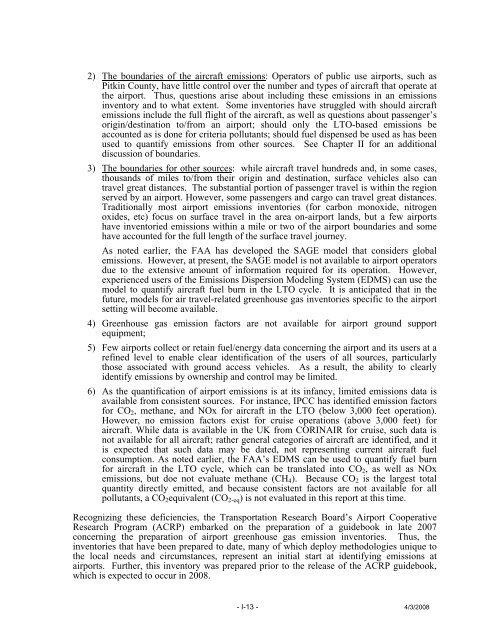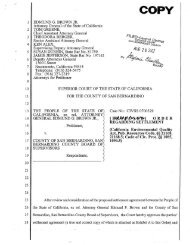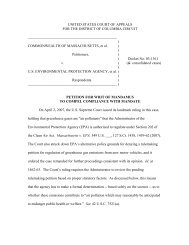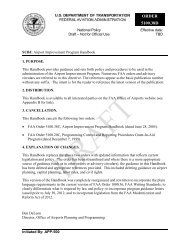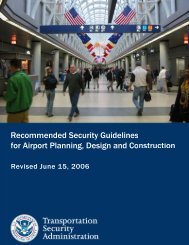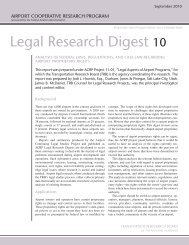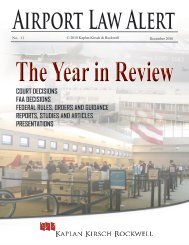Aspen-Pitkin County Airport Greenhouse Gas Emissions Inventory ...
Aspen-Pitkin County Airport Greenhouse Gas Emissions Inventory ...
Aspen-Pitkin County Airport Greenhouse Gas Emissions Inventory ...
Create successful ePaper yourself
Turn your PDF publications into a flip-book with our unique Google optimized e-Paper software.
2) The boundaries of the aircraft emissions: Operators of public use airports, such as<strong>Pitkin</strong> <strong>County</strong>, have little control over the number and types of aircraft that operate atthe airport. Thus, questions arise about including these emissions in an emissionsinventory and to what extent. Some inventories have struggled with should aircraftemissions include the full flight of the aircraft, as well as questions about passenger’sorigin/destination to/from an airport; should only the LTO-based emissions beaccounted as is done for criteria pollutants; should fuel dispensed be used as has beenused to quantify emissions from other sources. See Chapter II for an additionaldiscussion of boundaries.3) The boundaries for other sources: while aircraft travel hundreds and, in some cases,thousands of miles to/from their origin and destination, surface vehicles also cantravel great distances. The substantial portion of passenger travel is within the regionserved by an airport. However, some passengers and cargo can travel great distances.Traditionally most airport emissions inventories (for carbon monoxide, nitrogenoxides, etc) focus on surface travel in the area on-airport lands, but a few airportshave inventoried emissions within a mile or two of the airport boundaries and somehave accounted for the full length of the surface travel journey.As noted earlier, the FAA has developed the SAGE model that considers globalemissions. However, at present, the SAGE model is not available to airport operatorsdue to the extensive amount of information required for its operation. However,experienced users of the <strong>Emissions</strong> Dispersion Modeling System (EDMS) can use themodel to quantify aircraft fuel burn in the LTO cycle. It is anticipated that in thefuture, models for air travel-related greenhouse gas inventories specific to the airportsetting will become available.4) <strong>Greenhouse</strong> gas emission factors are not available for airport ground supportequipment;5) Few airports collect or retain fuel/energy data concerning the airport and its users at arefined level to enable clear identification of the users of all sources, particularlythose associated with ground access vehicles. As a result, the ability to clearlyidentify emissions by ownership and control may be limited.6) As the quantification of airport emissions is at its infancy, limited emissions data isavailable from consistent sources. For instance, IPCC has identified emission factorsfor CO 2 , methane, and NOx for aircraft in the LTO (below 3,000 feet operation).However, no emission factors exist for cruise operations (above 3,000 feet) foraircraft. While data is available in the UK from CORINAIR for cruise, such data isnot available for all aircraft; rather general categories of aircraft are identified, and itis expected that such data may be dated, not representing current aircraft fuelconsumption. As noted earlier, the FAA’s EDMS can be used to quantify fuel burnfor aircraft in the LTO cycle, which can be translated into CO 2 , as well as NOxemissions, but doe not evaluate methane (CH 4 ). Because CO 2 is the largest totalquantity directly emitted, and because consistent factors are not available for allpollutants, a CO 2 equivalent (CO 2-eq ) is not evaluated in this report at this time.Recognizing these deficiencies, the Transportation Research Board’s <strong>Airport</strong> CooperativeResearch Program (ACRP) embarked on the preparation of a guidebook in late 2007concerning the preparation of airport greenhouse gas emission inventories. Thus, theinventories that have been prepared to date, many of which deploy methodologies unique tothe local needs and circumstances, represent an initial start at identifying emissions atairports. Further, this inventory was prepared prior to the release of the ACRP guidebook,which is expected to occur in 2008.- I-13 - 4/3/2008


